Comprehensive Project Quality Management Plan for Sisense Software
VerifiedAdded on 2021/06/15
|10
|2891
|24
Report
AI Summary
This report presents a comprehensive quality management plan for the Sisense software development project. It outlines the importance of quality management from project initiation to completion, emphasizing stakeholder satisfaction through continuous improvement. The plan details quality definitions, metrics for planning, cost control, schedule management, and software quality, referencing ISO/IEC 25010:2011 standards. It includes a software testing checklist, change control processes, and integration of Total Quality Management (TQM) principles, including Agile SCRUM and Six Sigma methodologies. Benchmarking against competing BI software like Dundas BI and ClicData is also incorporated. The report describes team activities, matrix diagrams, and adherence to PMI/PMBoK guidelines, ensuring strict control over budgets and timelines, and managing changes through a defined change management plan. The document also includes the use of the seven basic tools of quality for problem identification and resolution.
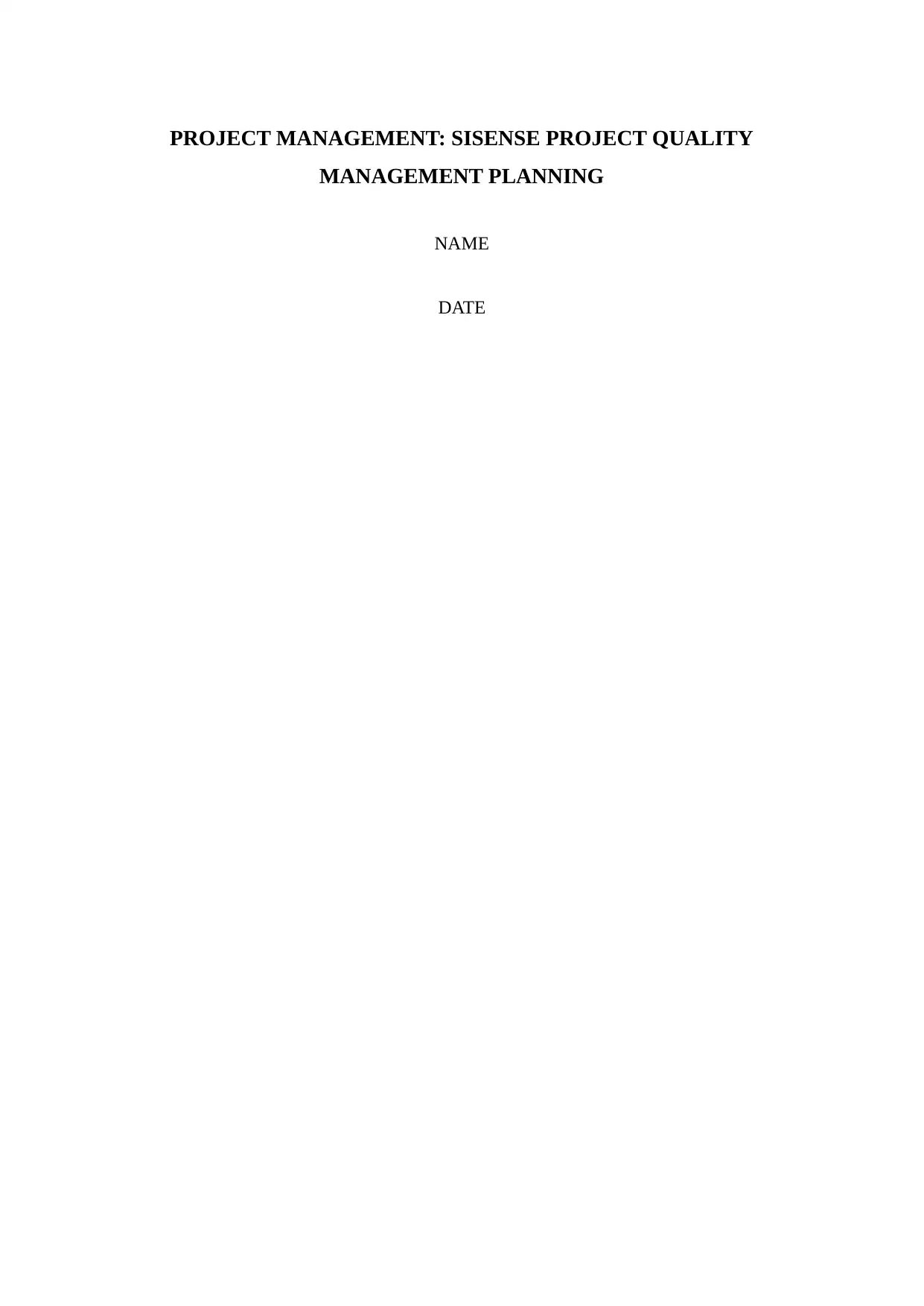
PROJECT MANAGEMENT: SISENSE PROJECT QUALITY
MANAGEMENT PLANNING
NAME
DATE
MANAGEMENT PLANNING
NAME
DATE
Paraphrase This Document
Need a fresh take? Get an instant paraphrase of this document with our AI Paraphraser
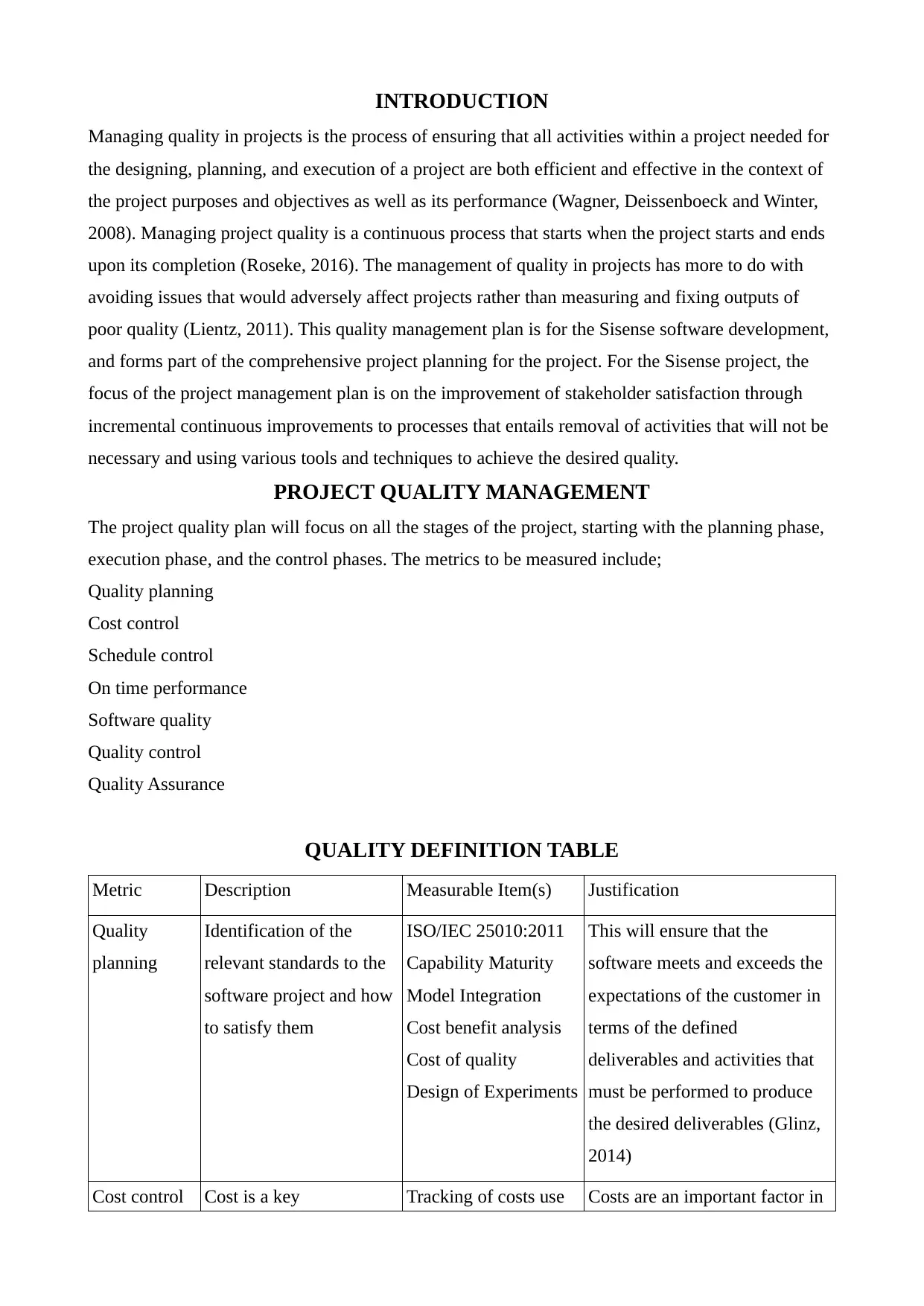
INTRODUCTION
Managing quality in projects is the process of ensuring that all activities within a project needed for
the designing, planning, and execution of a project are both efficient and effective in the context of
the project purposes and objectives as well as its performance (Wagner, Deissenboeck and Winter,
2008). Managing project quality is a continuous process that starts when the project starts and ends
upon its completion (Roseke, 2016). The management of quality in projects has more to do with
avoiding issues that would adversely affect projects rather than measuring and fixing outputs of
poor quality (Lientz, 2011). This quality management plan is for the Sisense software development,
and forms part of the comprehensive project planning for the project. For the Sisense project, the
focus of the project management plan is on the improvement of stakeholder satisfaction through
incremental continuous improvements to processes that entails removal of activities that will not be
necessary and using various tools and techniques to achieve the desired quality.
PROJECT QUALITY MANAGEMENT
The project quality plan will focus on all the stages of the project, starting with the planning phase,
execution phase, and the control phases. The metrics to be measured include;
Quality planning
Cost control
Schedule control
On time performance
Software quality
Quality control
Quality Assurance
QUALITY DEFINITION TABLE
Metric Description Measurable Item(s) Justification
Quality
planning
Identification of the
relevant standards to the
software project and how
to satisfy them
ISO/IEC 25010:2011
Capability Maturity
Model Integration
Cost benefit analysis
Cost of quality
Design of Experiments
This will ensure that the
software meets and exceeds the
expectations of the customer in
terms of the defined
deliverables and activities that
must be performed to produce
the desired deliverables (Glinz,
2014)
Cost control Cost is a key Tracking of costs use Costs are an important factor in
Managing quality in projects is the process of ensuring that all activities within a project needed for
the designing, planning, and execution of a project are both efficient and effective in the context of
the project purposes and objectives as well as its performance (Wagner, Deissenboeck and Winter,
2008). Managing project quality is a continuous process that starts when the project starts and ends
upon its completion (Roseke, 2016). The management of quality in projects has more to do with
avoiding issues that would adversely affect projects rather than measuring and fixing outputs of
poor quality (Lientz, 2011). This quality management plan is for the Sisense software development,
and forms part of the comprehensive project planning for the project. For the Sisense project, the
focus of the project management plan is on the improvement of stakeholder satisfaction through
incremental continuous improvements to processes that entails removal of activities that will not be
necessary and using various tools and techniques to achieve the desired quality.
PROJECT QUALITY MANAGEMENT
The project quality plan will focus on all the stages of the project, starting with the planning phase,
execution phase, and the control phases. The metrics to be measured include;
Quality planning
Cost control
Schedule control
On time performance
Software quality
Quality control
Quality Assurance
QUALITY DEFINITION TABLE
Metric Description Measurable Item(s) Justification
Quality
planning
Identification of the
relevant standards to the
software project and how
to satisfy them
ISO/IEC 25010:2011
Capability Maturity
Model Integration
Cost benefit analysis
Cost of quality
Design of Experiments
This will ensure that the
software meets and exceeds the
expectations of the customer in
terms of the defined
deliverables and activities that
must be performed to produce
the desired deliverables (Glinz,
2014)
Cost control Cost is a key Tracking of costs use Costs are an important factor in

performance indicator in
the project and entails
controlling costs through
planning, accurate
estimations, financing,
and budgeting
versus the budget
project executed and
completed within cost?
Budgeted Actual Cost
Actual Cost
Estimate to Complete
projects; under budgeting
results in cost overruns. Cost
control is the main subset in
managing projects; it ensures all
scope tasks are completed and
that resources are strictly
controlled to meet project
objectives (‘Clarizen,’ 2017)
Schedule
control
This is a quality aspect
where the project
activities schedule is
measured and compared
with the project schedule
baseline to ensure
deliverables are met
Dependencies
Work Breakdown
Structure
Schedule Variance
Scope changes
Proper scheduling that ensures
all dependencies are accurately
scheduled and lag time is well
managed ensures the project
will be successfully completed
On time
performance
Measures whether the
project milestones are
met as planned
Time of delivery of
milestones
Tis is essential in ensuring that
the desired deliverables are met
as per the project schedule
Quality
control
Entails the observation of
activities and techniques
used for fulfilling quality
requirements
Seven basic tools of
quality control
Inspection
Statistical sampling
Approved change
review requests
Ensures that any issues and their
root causes are identified and
dealt with at the source in a
continuous process (Botha,
Bortham and Nel, 2015)
Software
quality
This refers to the degree
by which a system,
component, or process
meets specified
requirements and
customer needs; its the
totality of the features
and functionality of a
software product bearing
Mean time to failure
Defect density
Customer problems
This is an important metric
because it is the most important
outcome and measure of project
success; the software quality
must meet the desired
performance and customer
requirements; for instance, error
tolerance, error reporting, and
ability to function under high
the project and entails
controlling costs through
planning, accurate
estimations, financing,
and budgeting
versus the budget
project executed and
completed within cost?
Budgeted Actual Cost
Actual Cost
Estimate to Complete
projects; under budgeting
results in cost overruns. Cost
control is the main subset in
managing projects; it ensures all
scope tasks are completed and
that resources are strictly
controlled to meet project
objectives (‘Clarizen,’ 2017)
Schedule
control
This is a quality aspect
where the project
activities schedule is
measured and compared
with the project schedule
baseline to ensure
deliverables are met
Dependencies
Work Breakdown
Structure
Schedule Variance
Scope changes
Proper scheduling that ensures
all dependencies are accurately
scheduled and lag time is well
managed ensures the project
will be successfully completed
On time
performance
Measures whether the
project milestones are
met as planned
Time of delivery of
milestones
Tis is essential in ensuring that
the desired deliverables are met
as per the project schedule
Quality
control
Entails the observation of
activities and techniques
used for fulfilling quality
requirements
Seven basic tools of
quality control
Inspection
Statistical sampling
Approved change
review requests
Ensures that any issues and their
root causes are identified and
dealt with at the source in a
continuous process (Botha,
Bortham and Nel, 2015)
Software
quality
This refers to the degree
by which a system,
component, or process
meets specified
requirements and
customer needs; its the
totality of the features
and functionality of a
software product bearing
Mean time to failure
Defect density
Customer problems
This is an important metric
because it is the most important
outcome and measure of project
success; the software quality
must meet the desired
performance and customer
requirements; for instance, error
tolerance, error reporting, and
ability to function under high
⊘ This is a preview!⊘
Do you want full access?
Subscribe today to unlock all pages.

Trusted by 1+ million students worldwide
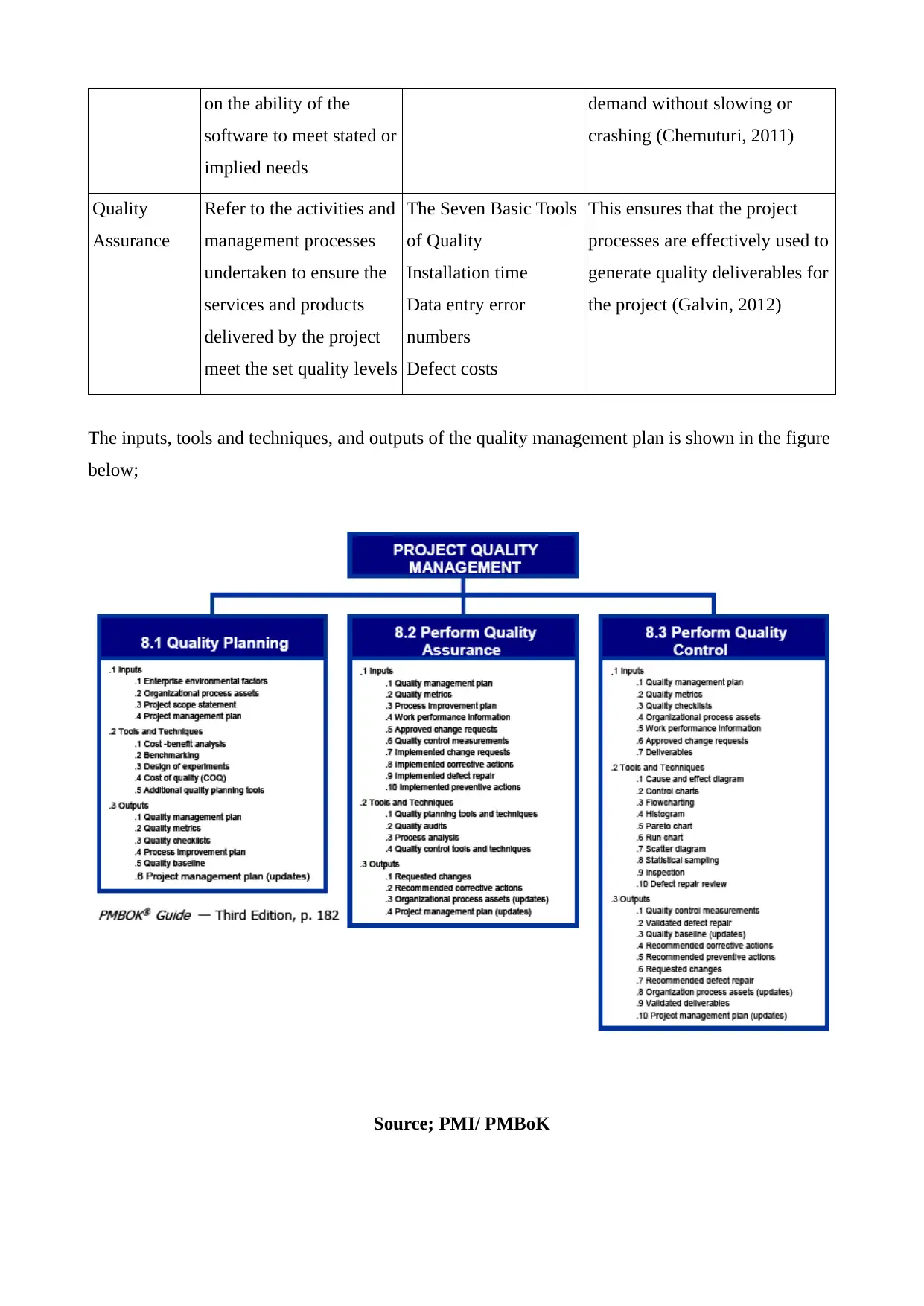
on the ability of the
software to meet stated or
implied needs
demand without slowing or
crashing (Chemuturi, 2011)
Quality
Assurance
Refer to the activities and
management processes
undertaken to ensure the
services and products
delivered by the project
meet the set quality levels
The Seven Basic Tools
of Quality
Installation time
Data entry error
numbers
Defect costs
This ensures that the project
processes are effectively used to
generate quality deliverables for
the project (Galvin, 2012)
The inputs, tools and techniques, and outputs of the quality management plan is shown in the figure
below;
Source; PMI/ PMBoK
software to meet stated or
implied needs
demand without slowing or
crashing (Chemuturi, 2011)
Quality
Assurance
Refer to the activities and
management processes
undertaken to ensure the
services and products
delivered by the project
meet the set quality levels
The Seven Basic Tools
of Quality
Installation time
Data entry error
numbers
Defect costs
This ensures that the project
processes are effectively used to
generate quality deliverables for
the project (Galvin, 2012)
The inputs, tools and techniques, and outputs of the quality management plan is shown in the figure
below;
Source; PMI/ PMBoK
Paraphrase This Document
Need a fresh take? Get an instant paraphrase of this document with our AI Paraphraser
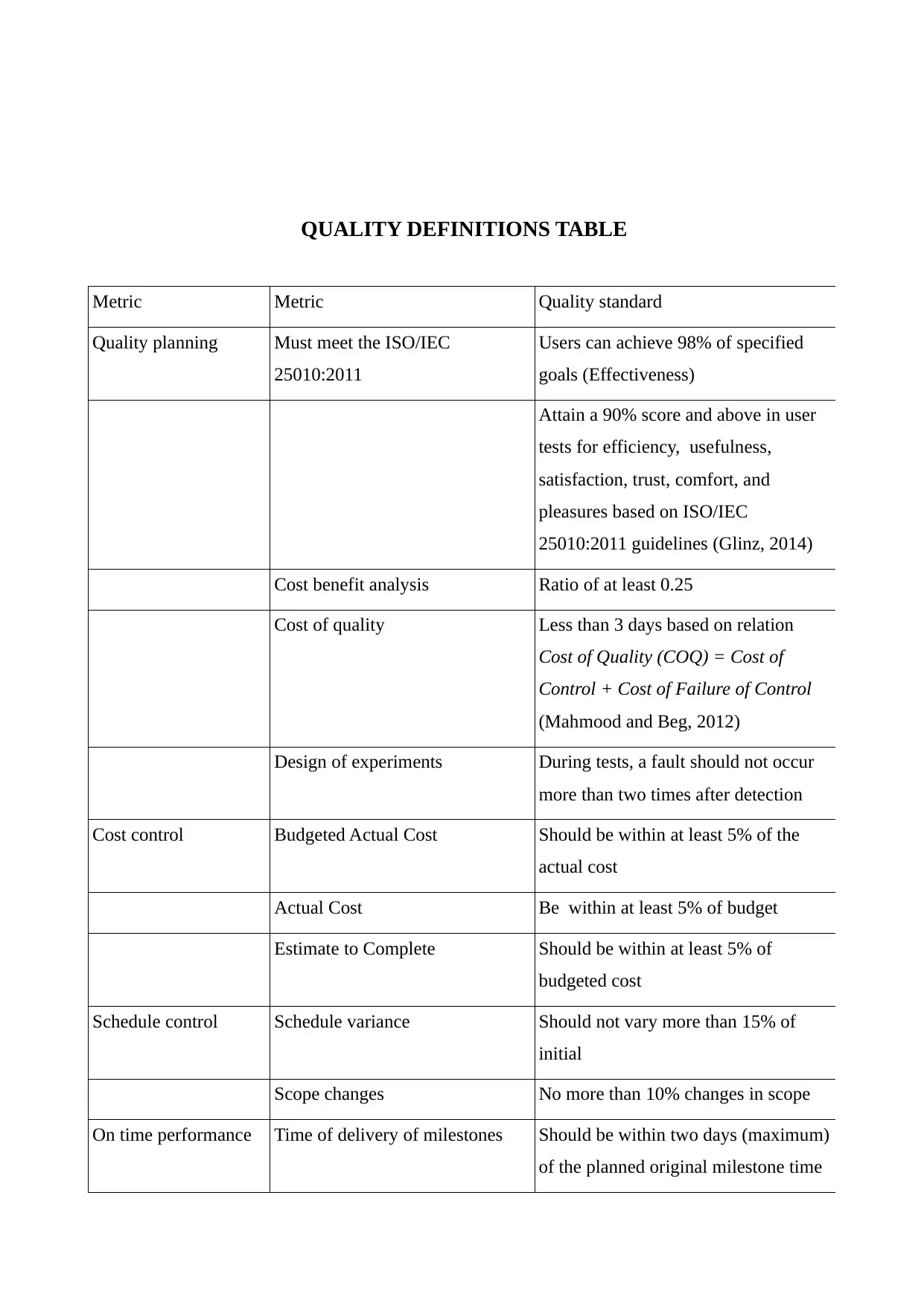
QUALITY DEFINITIONS TABLE
Metric Metric Quality standard
Quality planning Must meet the ISO/IEC
25010:2011
Users can achieve 98% of specified
goals (Effectiveness)
Attain a 90% score and above in user
tests for efficiency, usefulness,
satisfaction, trust, comfort, and
pleasures based on ISO/IEC
25010:2011 guidelines (Glinz, 2014)
Cost benefit analysis Ratio of at least 0.25
Cost of quality Less than 3 days based on relation
Cost of Quality (COQ) = Cost of
Control + Cost of Failure of Control
(Mahmood and Beg, 2012)
Design of experiments During tests, a fault should not occur
more than two times after detection
Cost control Budgeted Actual Cost Should be within at least 5% of the
actual cost
Actual Cost Be within at least 5% of budget
Estimate to Complete Should be within at least 5% of
budgeted cost
Schedule control Schedule variance Should not vary more than 15% of
initial
Scope changes No more than 10% changes in scope
On time performance Time of delivery of milestones Should be within two days (maximum)
of the planned original milestone time
Metric Metric Quality standard
Quality planning Must meet the ISO/IEC
25010:2011
Users can achieve 98% of specified
goals (Effectiveness)
Attain a 90% score and above in user
tests for efficiency, usefulness,
satisfaction, trust, comfort, and
pleasures based on ISO/IEC
25010:2011 guidelines (Glinz, 2014)
Cost benefit analysis Ratio of at least 0.25
Cost of quality Less than 3 days based on relation
Cost of Quality (COQ) = Cost of
Control + Cost of Failure of Control
(Mahmood and Beg, 2012)
Design of experiments During tests, a fault should not occur
more than two times after detection
Cost control Budgeted Actual Cost Should be within at least 5% of the
actual cost
Actual Cost Be within at least 5% of budget
Estimate to Complete Should be within at least 5% of
budgeted cost
Schedule control Schedule variance Should not vary more than 15% of
initial
Scope changes No more than 10% changes in scope
On time performance Time of delivery of milestones Should be within two days (maximum)
of the planned original milestone time
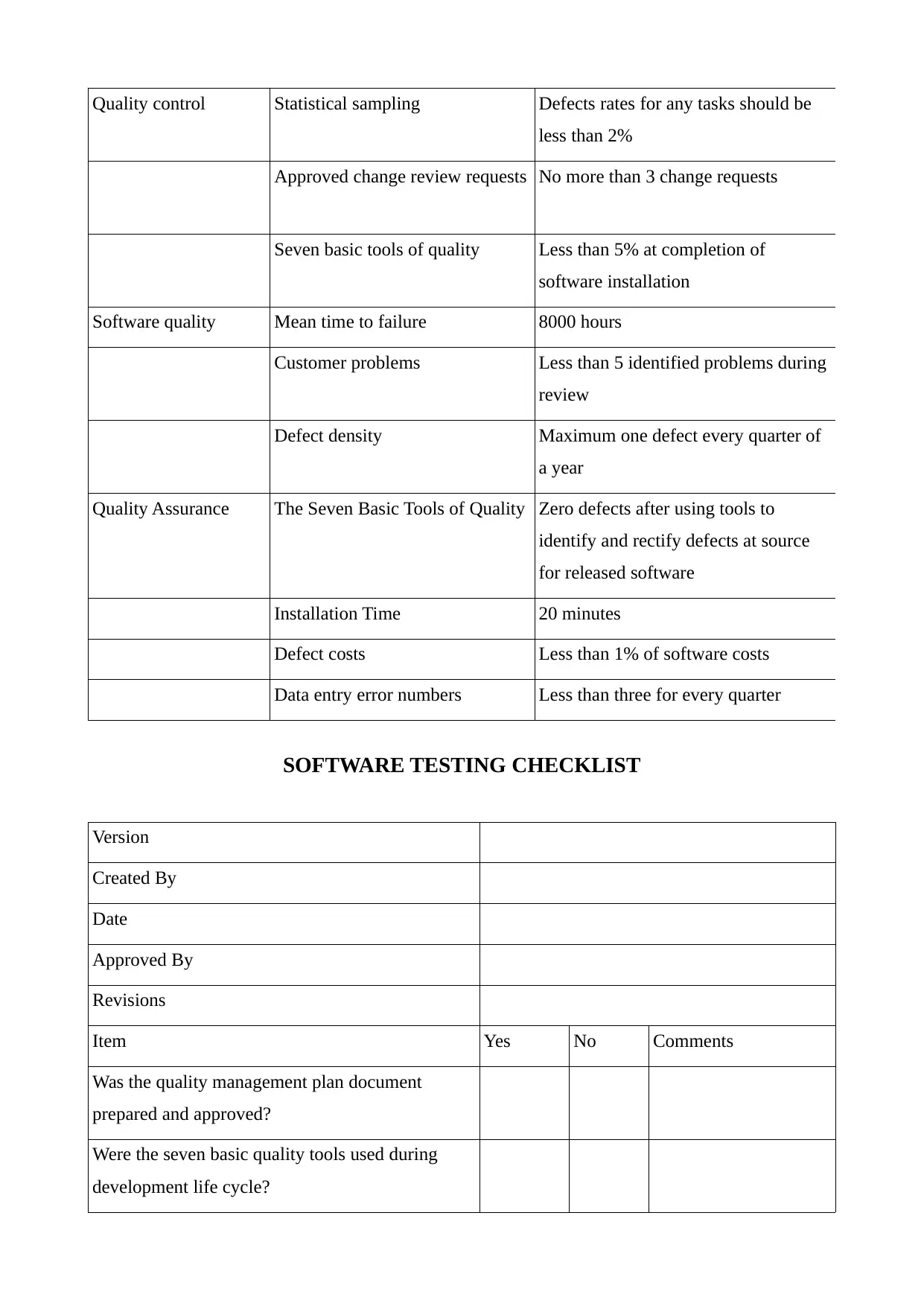
Quality control Statistical sampling Defects rates for any tasks should be
less than 2%
Approved change review requests No more than 3 change requests
Seven basic tools of quality Less than 5% at completion of
software installation
Software quality Mean time to failure 8000 hours
Customer problems Less than 5 identified problems during
review
Defect density Maximum one defect every quarter of
a year
Quality Assurance The Seven Basic Tools of Quality Zero defects after using tools to
identify and rectify defects at source
for released software
Installation Time 20 minutes
Defect costs Less than 1% of software costs
Data entry error numbers Less than three for every quarter
SOFTWARE TESTING CHECKLIST
Version
Created By
Date
Approved By
Revisions
Item Yes No Comments
Was the quality management plan document
prepared and approved?
Were the seven basic quality tools used during
development life cycle?
less than 2%
Approved change review requests No more than 3 change requests
Seven basic tools of quality Less than 5% at completion of
software installation
Software quality Mean time to failure 8000 hours
Customer problems Less than 5 identified problems during
review
Defect density Maximum one defect every quarter of
a year
Quality Assurance The Seven Basic Tools of Quality Zero defects after using tools to
identify and rectify defects at source
for released software
Installation Time 20 minutes
Defect costs Less than 1% of software costs
Data entry error numbers Less than three for every quarter
SOFTWARE TESTING CHECKLIST
Version
Created By
Date
Approved By
Revisions
Item Yes No Comments
Was the quality management plan document
prepared and approved?
Were the seven basic quality tools used during
development life cycle?
⊘ This is a preview!⊘
Do you want full access?
Subscribe today to unlock all pages.

Trusted by 1+ million students worldwide
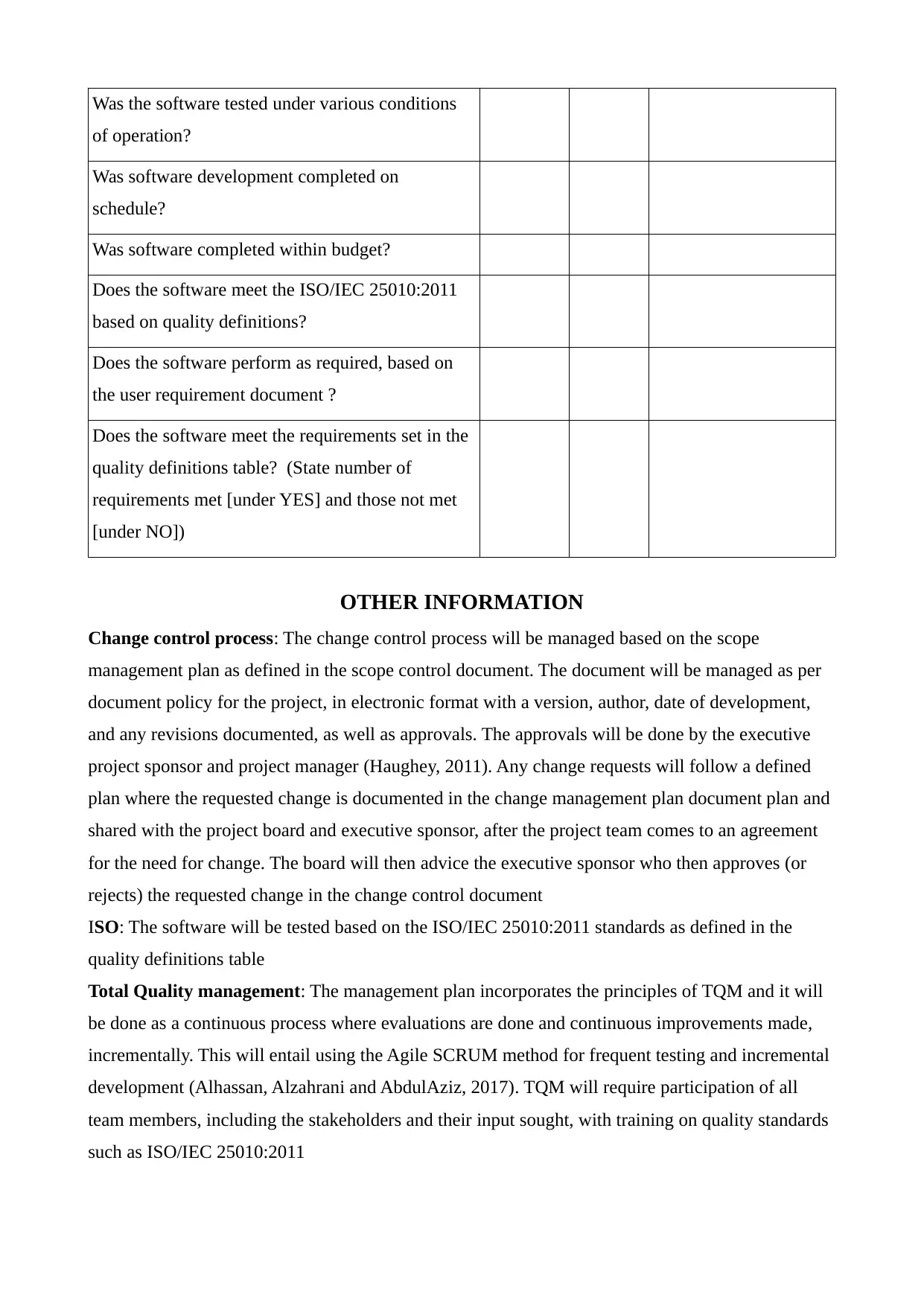
Was the software tested under various conditions
of operation?
Was software development completed on
schedule?
Was software completed within budget?
Does the software meet the ISO/IEC 25010:2011
based on quality definitions?
Does the software perform as required, based on
the user requirement document ?
Does the software meet the requirements set in the
quality definitions table? (State number of
requirements met [under YES] and those not met
[under NO])
OTHER INFORMATION
Change control process: The change control process will be managed based on the scope
management plan as defined in the scope control document. The document will be managed as per
document policy for the project, in electronic format with a version, author, date of development,
and any revisions documented, as well as approvals. The approvals will be done by the executive
project sponsor and project manager (Haughey, 2011). Any change requests will follow a defined
plan where the requested change is documented in the change management plan document plan and
shared with the project board and executive sponsor, after the project team comes to an agreement
for the need for change. The board will then advice the executive sponsor who then approves (or
rejects) the requested change in the change control document
ISO: The software will be tested based on the ISO/IEC 25010:2011 standards as defined in the
quality definitions table
Total Quality management: The management plan incorporates the principles of TQM and it will
be done as a continuous process where evaluations are done and continuous improvements made,
incrementally. This will entail using the Agile SCRUM method for frequent testing and incremental
development (Alhassan, Alzahrani and AbdulAziz, 2017). TQM will require participation of all
team members, including the stakeholders and their input sought, with training on quality standards
such as ISO/IEC 25010:2011
of operation?
Was software development completed on
schedule?
Was software completed within budget?
Does the software meet the ISO/IEC 25010:2011
based on quality definitions?
Does the software perform as required, based on
the user requirement document ?
Does the software meet the requirements set in the
quality definitions table? (State number of
requirements met [under YES] and those not met
[under NO])
OTHER INFORMATION
Change control process: The change control process will be managed based on the scope
management plan as defined in the scope control document. The document will be managed as per
document policy for the project, in electronic format with a version, author, date of development,
and any revisions documented, as well as approvals. The approvals will be done by the executive
project sponsor and project manager (Haughey, 2011). Any change requests will follow a defined
plan where the requested change is documented in the change management plan document plan and
shared with the project board and executive sponsor, after the project team comes to an agreement
for the need for change. The board will then advice the executive sponsor who then approves (or
rejects) the requested change in the change control document
ISO: The software will be tested based on the ISO/IEC 25010:2011 standards as defined in the
quality definitions table
Total Quality management: The management plan incorporates the principles of TQM and it will
be done as a continuous process where evaluations are done and continuous improvements made,
incrementally. This will entail using the Agile SCRUM method for frequent testing and incremental
development (Alhassan, Alzahrani and AbdulAziz, 2017). TQM will require participation of all
team members, including the stakeholders and their input sought, with training on quality standards
such as ISO/IEC 25010:2011
Paraphrase This Document
Need a fresh take? Get an instant paraphrase of this document with our AI Paraphraser

Six Sigma: The method will be used during weekly sprint tests done on software performance and
will form the overall quality management plan; it will form part of statistical sampling where no
more than 3.4 defects are allowed for every million opportunities (Ghane, 2014); the tests will be
extrapolated based on this principle, such as mean time to failure.
Benchmarking: The performance of the Sisense system will be benchmarked in terms of
performance and quality against Dundas BI TM software and against ClicData TM ; these are
competing business intelligence softwares that have been rated as being among the best performers
('Software Advice', 2018)
GROUP WORK ACTIVITIES
The team will brainstorm over quality issues and the best ways to meet the quality requirements by
having structured meetings with the team leader facilitating the brainstorming. All members will
give their points and these will be discussed and adopted if a general agreement is reached. The
benchmarking will be done with the softwares listed in the previous section and metrics such as
installation time and then ranked. The teams will then develop various quality measures, based on
the seven basic tools for quality to identify problems and resolve them; the specific tools to be used
include the histogram, flow charts, and scatter diagrams
MATRIX DIAGRAM
Customer Requirements
Performance Interoperabil
ity
Ease of Use Efficiency Usefulness Effectiveness
OTHERS
The validity of the methods to use for testing quality are based on guidelines by the PMI and based
on PMBoK principles for managing quality in software projects.
Change will be managed based on the change management plan and document to ensure strict
control of changes
Project control plan will ensure the budgets and time constraints are strictly controlled; the project
baseline and budget baseline will be used in ensuring these requirements are met
The documents will be managed according to the documentation policy where each document will
have a responsible person assigned to ts management. The documents will be in electronic form and
and will have a version, date created, and approval requirements, with any revisions approved and
will form the overall quality management plan; it will form part of statistical sampling where no
more than 3.4 defects are allowed for every million opportunities (Ghane, 2014); the tests will be
extrapolated based on this principle, such as mean time to failure.
Benchmarking: The performance of the Sisense system will be benchmarked in terms of
performance and quality against Dundas BI TM software and against ClicData TM ; these are
competing business intelligence softwares that have been rated as being among the best performers
('Software Advice', 2018)
GROUP WORK ACTIVITIES
The team will brainstorm over quality issues and the best ways to meet the quality requirements by
having structured meetings with the team leader facilitating the brainstorming. All members will
give their points and these will be discussed and adopted if a general agreement is reached. The
benchmarking will be done with the softwares listed in the previous section and metrics such as
installation time and then ranked. The teams will then develop various quality measures, based on
the seven basic tools for quality to identify problems and resolve them; the specific tools to be used
include the histogram, flow charts, and scatter diagrams
MATRIX DIAGRAM
Customer Requirements
Performance Interoperabil
ity
Ease of Use Efficiency Usefulness Effectiveness
OTHERS
The validity of the methods to use for testing quality are based on guidelines by the PMI and based
on PMBoK principles for managing quality in software projects.
Change will be managed based on the change management plan and document to ensure strict
control of changes
Project control plan will ensure the budgets and time constraints are strictly controlled; the project
baseline and budget baseline will be used in ensuring these requirements are met
The documents will be managed according to the documentation policy where each document will
have a responsible person assigned to ts management. The documents will be in electronic form and
and will have a version, date created, and approval requirements, with any revisions approved and
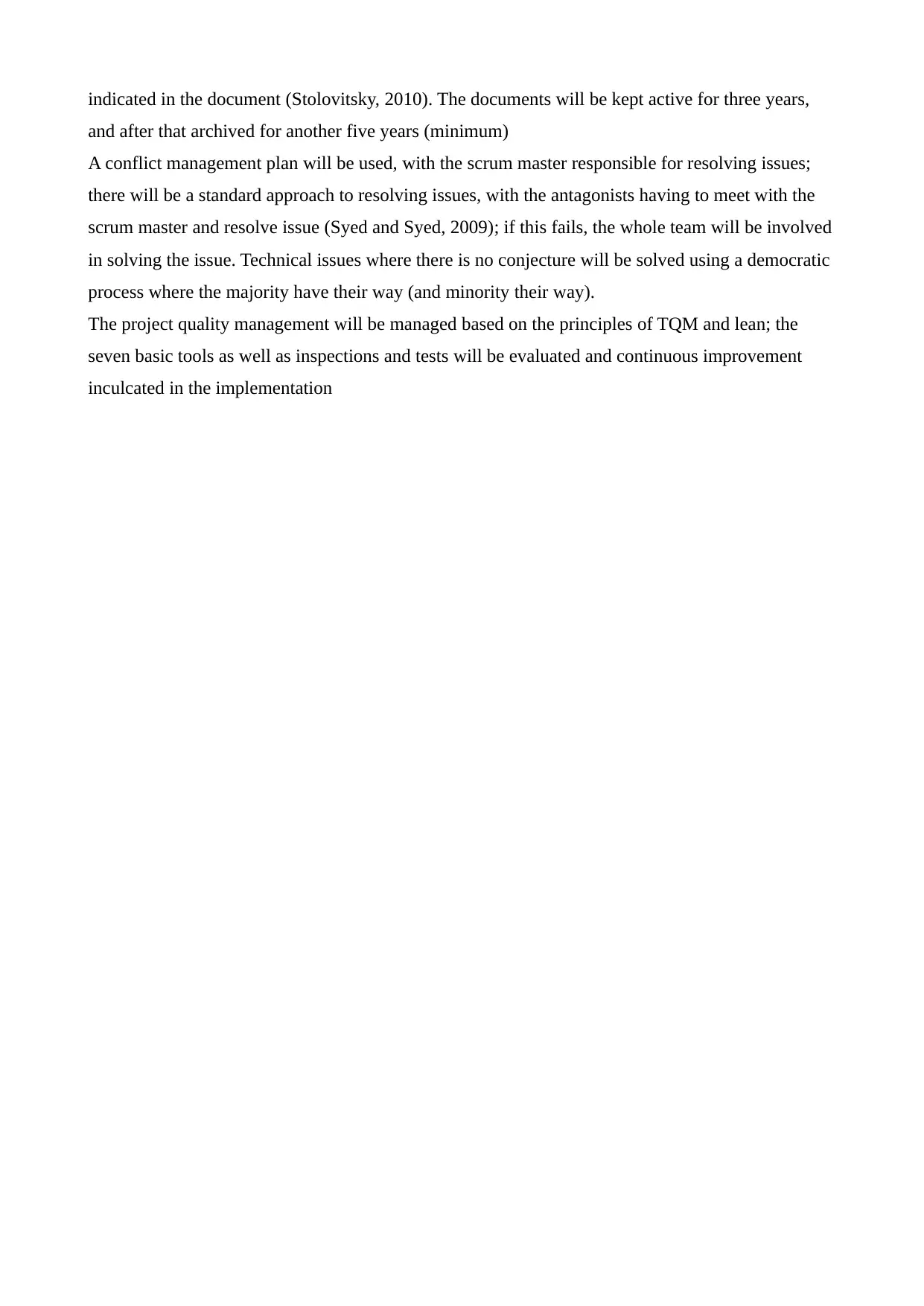
indicated in the document (Stolovitsky, 2010). The documents will be kept active for three years,
and after that archived for another five years (minimum)
A conflict management plan will be used, with the scrum master responsible for resolving issues;
there will be a standard approach to resolving issues, with the antagonists having to meet with the
scrum master and resolve issue (Syed and Syed, 2009); if this fails, the whole team will be involved
in solving the issue. Technical issues where there is no conjecture will be solved using a democratic
process where the majority have their way (and minority their way).
The project quality management will be managed based on the principles of TQM and lean; the
seven basic tools as well as inspections and tests will be evaluated and continuous improvement
inculcated in the implementation
and after that archived for another five years (minimum)
A conflict management plan will be used, with the scrum master responsible for resolving issues;
there will be a standard approach to resolving issues, with the antagonists having to meet with the
scrum master and resolve issue (Syed and Syed, 2009); if this fails, the whole team will be involved
in solving the issue. Technical issues where there is no conjecture will be solved using a democratic
process where the majority have their way (and minority their way).
The project quality management will be managed based on the principles of TQM and lean; the
seven basic tools as well as inspections and tests will be evaluated and continuous improvement
inculcated in the implementation
⊘ This is a preview!⊘
Do you want full access?
Subscribe today to unlock all pages.

Trusted by 1+ million students worldwide
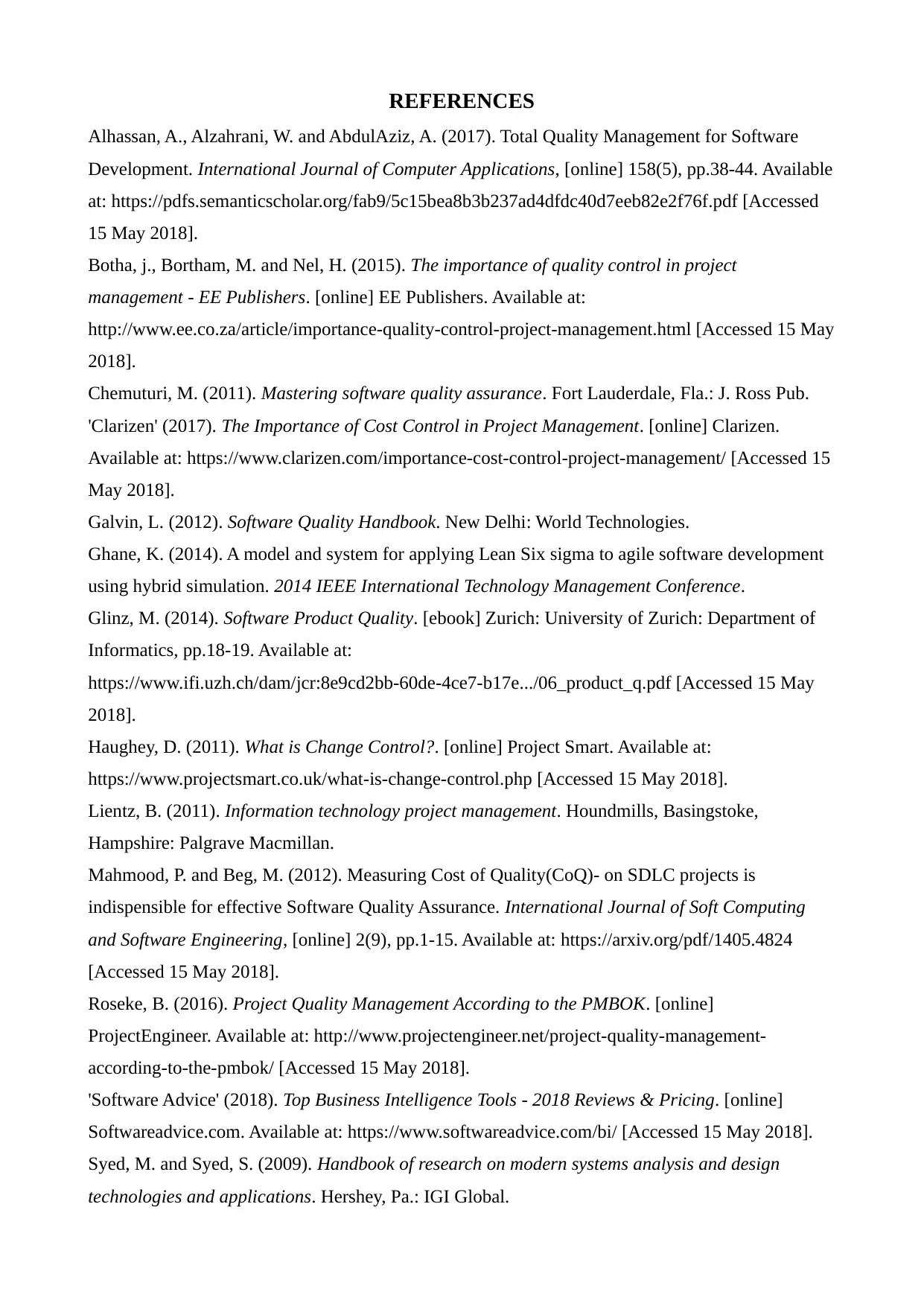
REFERENCES
Alhassan, A., Alzahrani, W. and AbdulAziz, A. (2017). Total Quality Management for Software
Development. International Journal of Computer Applications, [online] 158(5), pp.38-44. Available
at: https://pdfs.semanticscholar.org/fab9/5c15bea8b3b237ad4dfdc40d7eeb82e2f76f.pdf [Accessed
15 May 2018].
Botha, j., Bortham, M. and Nel, H. (2015). The importance of quality control in project
management - EE Publishers. [online] EE Publishers. Available at:
http://www.ee.co.za/article/importance-quality-control-project-management.html [Accessed 15 May
2018].
Chemuturi, M. (2011). Mastering software quality assurance. Fort Lauderdale, Fla.: J. Ross Pub.
'Clarizen' (2017). The Importance of Cost Control in Project Management. [online] Clarizen.
Available at: https://www.clarizen.com/importance-cost-control-project-management/ [Accessed 15
May 2018].
Galvin, L. (2012). Software Quality Handbook. New Delhi: World Technologies.
Ghane, K. (2014). A model and system for applying Lean Six sigma to agile software development
using hybrid simulation. 2014 IEEE International Technology Management Conference.
Glinz, M. (2014). Software Product Quality. [ebook] Zurich: University of Zurich: Department of
Informatics, pp.18-19. Available at:
https://www.ifi.uzh.ch/dam/jcr:8e9cd2bb-60de-4ce7-b17e.../06_product_q.pdf [Accessed 15 May
2018].
Haughey, D. (2011). What is Change Control?. [online] Project Smart. Available at:
https://www.projectsmart.co.uk/what-is-change-control.php [Accessed 15 May 2018].
Lientz, B. (2011). Information technology project management. Houndmills, Basingstoke,
Hampshire: Palgrave Macmillan.
Mahmood, P. and Beg, M. (2012). Measuring Cost of Quality(CoQ)- on SDLC projects is
indispensible for effective Software Quality Assurance. International Journal of Soft Computing
and Software Engineering, [online] 2(9), pp.1-15. Available at: https://arxiv.org/pdf/1405.4824
[Accessed 15 May 2018].
Roseke, B. (2016). Project Quality Management According to the PMBOK. [online]
ProjectEngineer. Available at: http://www.projectengineer.net/project-quality-management-
according-to-the-pmbok/ [Accessed 15 May 2018].
'Software Advice' (2018). Top Business Intelligence Tools - 2018 Reviews & Pricing. [online]
Softwareadvice.com. Available at: https://www.softwareadvice.com/bi/ [Accessed 15 May 2018].
Syed, M. and Syed, S. (2009). Handbook of research on modern systems analysis and design
technologies and applications. Hershey, Pa.: IGI Global.
Alhassan, A., Alzahrani, W. and AbdulAziz, A. (2017). Total Quality Management for Software
Development. International Journal of Computer Applications, [online] 158(5), pp.38-44. Available
at: https://pdfs.semanticscholar.org/fab9/5c15bea8b3b237ad4dfdc40d7eeb82e2f76f.pdf [Accessed
15 May 2018].
Botha, j., Bortham, M. and Nel, H. (2015). The importance of quality control in project
management - EE Publishers. [online] EE Publishers. Available at:
http://www.ee.co.za/article/importance-quality-control-project-management.html [Accessed 15 May
2018].
Chemuturi, M. (2011). Mastering software quality assurance. Fort Lauderdale, Fla.: J. Ross Pub.
'Clarizen' (2017). The Importance of Cost Control in Project Management. [online] Clarizen.
Available at: https://www.clarizen.com/importance-cost-control-project-management/ [Accessed 15
May 2018].
Galvin, L. (2012). Software Quality Handbook. New Delhi: World Technologies.
Ghane, K. (2014). A model and system for applying Lean Six sigma to agile software development
using hybrid simulation. 2014 IEEE International Technology Management Conference.
Glinz, M. (2014). Software Product Quality. [ebook] Zurich: University of Zurich: Department of
Informatics, pp.18-19. Available at:
https://www.ifi.uzh.ch/dam/jcr:8e9cd2bb-60de-4ce7-b17e.../06_product_q.pdf [Accessed 15 May
2018].
Haughey, D. (2011). What is Change Control?. [online] Project Smart. Available at:
https://www.projectsmart.co.uk/what-is-change-control.php [Accessed 15 May 2018].
Lientz, B. (2011). Information technology project management. Houndmills, Basingstoke,
Hampshire: Palgrave Macmillan.
Mahmood, P. and Beg, M. (2012). Measuring Cost of Quality(CoQ)- on SDLC projects is
indispensible for effective Software Quality Assurance. International Journal of Soft Computing
and Software Engineering, [online] 2(9), pp.1-15. Available at: https://arxiv.org/pdf/1405.4824
[Accessed 15 May 2018].
Roseke, B. (2016). Project Quality Management According to the PMBOK. [online]
ProjectEngineer. Available at: http://www.projectengineer.net/project-quality-management-
according-to-the-pmbok/ [Accessed 15 May 2018].
'Software Advice' (2018). Top Business Intelligence Tools - 2018 Reviews & Pricing. [online]
Softwareadvice.com. Available at: https://www.softwareadvice.com/bi/ [Accessed 15 May 2018].
Syed, M. and Syed, S. (2009). Handbook of research on modern systems analysis and design
technologies and applications. Hershey, Pa.: IGI Global.
1 out of 10
Related Documents
Your All-in-One AI-Powered Toolkit for Academic Success.
+13062052269
info@desklib.com
Available 24*7 on WhatsApp / Email
![[object Object]](/_next/static/media/star-bottom.7253800d.svg)
Unlock your academic potential
Copyright © 2020–2025 A2Z Services. All Rights Reserved. Developed and managed by ZUCOL.





